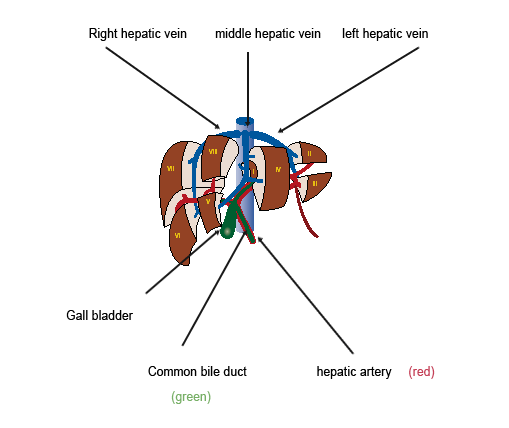The liver - anatomy and function
The liver weighs 3 to 4 pounds (1.0 to 1.4 kilograms) and is not only the heaviest organ but also the largest gland in the human body. The reddish-brown organ is located in the upper right part of the abdomen just below the diaphragm and is protected by the lower ribs.
The liver is divided into a right and a left lobe. The right lobe, which is much larger than the left one, fills nearly the entire upper abdominal cavity. The smaller left lobe extends to the middle of the left upper abdomen.
Fig. 1: Scheme of liver segments I-VIII
Modified from Scherübl et al., Patientenbroschüre Falkfoundation 2012
The liver is surrounded by a dense connective tissue capsule, which in turn is almost completely covered by peritoneum.
Its interior consists of many tiny lobules, which are small functional units made up of numerous liver cells (hepatocytes).
Two different vessels supply blood to the liver: the hepatic artery and the portal vein. Both vessels enter the liver at the porta hepatis, a slit-like depression on the surface of the organ. Coming from the abdominal aorta, the hepatic artery delivers oxygen-rich blood to the liver cells. The portal vein transports blood from the bowel, stomach, pancreas, spleen and gallbladder to the liver. Thus the portal vein brings to the liver all substances that enter the circulation with food, whether nutrients or poisons.
The two vascular systems branch into fine capillary meshes in the liver. Thus the substances they transport reach the individual liver cells and can be further processed there.
The bile produced by the liver cells flows through a fine mesh of bile capillaries that drain into the hepatic duct, which exits the liver via the porta hepatis and opens into the duodenum.
The liver is the central metabolic organ of the body and performs vital tasks:
- It produces up to one liter of bile per day, which passes into the duodenum through the hepatic duct, the gallbladder serving as a temporary storage unit. Bile is needed for the digestion of fats.
- It takes up digestible substances from the intestine and utilizes them. For example, the liver converts dietary protein to body protein, stores carbohydrates and supplies nutrients to the body’s cells via the blood.
- It acts as the body’s detoxification center: pollutants, alcohol, and drugs as well as certain body substances are converted and broken down in the liver and in this way “rendered harmless.”
- It produces the starting materials for the sex hormones and body fats, breaks down old blood cells, and stores iron. The liver also helps regulate blood sugar levels.
Good liver function is essential: we cannot live without a liver.
Contact
Center of Interventional Hepatobiliary Medicine
Prof. Dr. med. Hans Scherübl
Vivantes Klinikum Am Urban
Academic Teaching Hospital of Charité, Berlin
Dieffenbachstraße 1
10967 Berlin
Tel: + 49 30 130 225201
Fax: + 49 30 130 225205
Email: This email address is being protected from spambots. You need JavaScript enabled to view it.
vivantes.de/kau/gastro/
